This set of photographs is a montage of images of White-tailed Deer recorded with Trail Cameras near Lewisville Lake over the course of 28 days. The trail Cameras were installed in the bed of a recently dried pond.
When I first found the pond bed I discovered it criss-crossed with deer tracks (and those of other animals) indicating that this place appealed strongly to the area’s wildlife.
Of particular note in this set is a curious young deer’s investigation of a camera. A buck with elaborately non-typical antlers makes an appearance early on a foggy morning. And, finally, there is an eerie photograph of a strange and bizarre headless deer.
Notice the plants in these pictures. These plants have small yellow flowers and stalks that can grow to be quite tall. Perhaps the most remarkable thing about the plants is the way their leaves fold up at night time. If anyone knows the name of these plants I would be interested in learning more about them. Please drop me a line or leave a comment below.

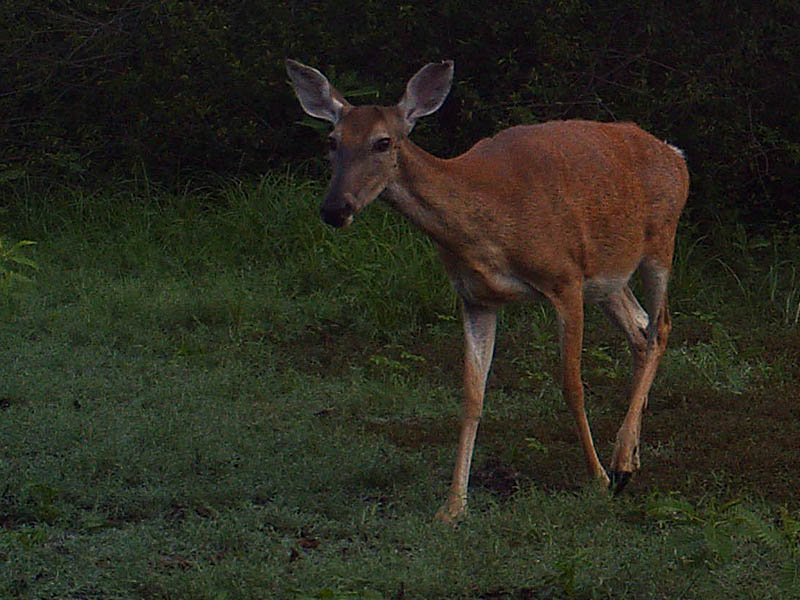









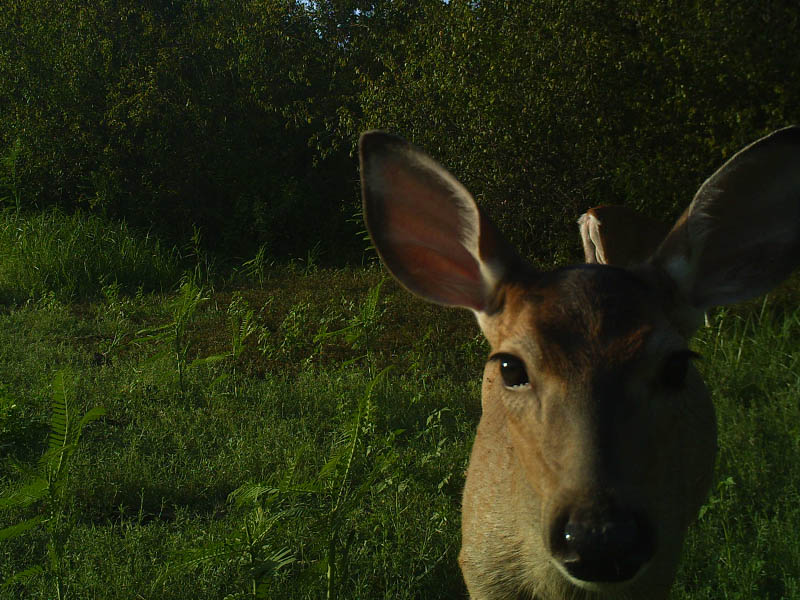

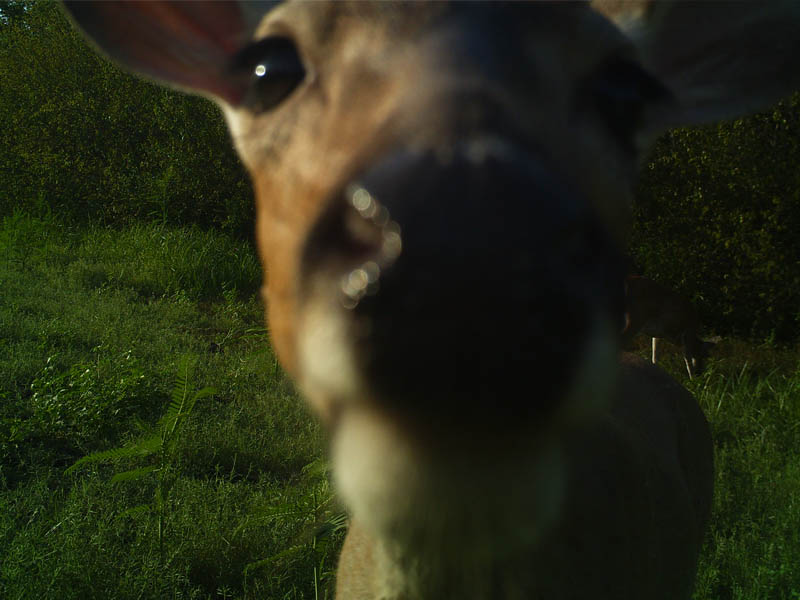



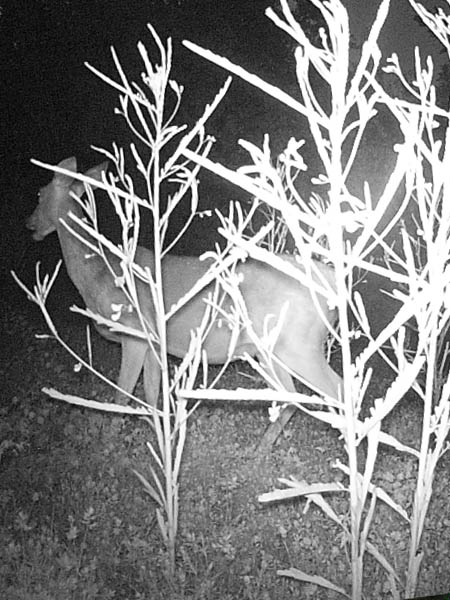



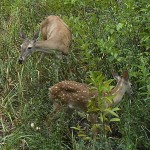

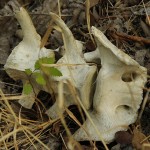

Chris, it is hard to tell the leaf shape of the plants for sure, and perspective makes the height uncertain. They appear to be similar to Tall Evening Primrose. Tall Evening Primrose occurs in a wide range of habitats, but is common in disturbed areas and recently dried wetlands. The plant is frequently up to 7 or 8 feet tall. The leaves are strap like. Flowers are as you said yellow. They are maybe 5/8 inch across, with 4 petals. The flowers are born in leaf axils, and open at the top of the plant first, with opening moving down the stem as fall progresses. Several flowers are open at one time, but the plant actually bears hundreds over the course of the late summer/early fall. This plant, which blooms during migration time for both Monarch Butterflies and hummingbirds, is a major nectar source for both, as well as other butterflies.
Nice set of photos. The “headless” deer, with its head in the bushes, is striking, as is the one with the contorted and numerous antler points.
Well, David, I did a quick Google search on “Tall Evening Primrose” and it doesn’t look like a good match to me.
These plants have leaves that remind me of something we used to call Sleepy Weed—only much larger. In fact, it appears that the leaves on these plants are folding up at night in much the same way that Sleepy Weed closes when it is touched. The closest match I could find online last was something called Partridge Pea—but I couldn’t convince myself that was a good ID. I think Partridge Pea is a smaller plant with more than just a single main stalk.
The plants in my photos did grow to be quite tall over the time I was recording pictures. Around 4 or 5 feet tall I would guess. I included that last picture specifically to illustrate the rapid growth of these plants (although now I am second guessing my claim that I recorded just an 8 day period—I am going to double check my dates when I get home tonight). Some of these pictures are cropped more tightly than others, but they are all taken from the same vantage point.
If you look carefully at the last picture you can make out several of the tiny flowers coming off some of the branches. I will try to post some better pictures of the plant a little later this afternoon.
That buck with the non-typical rack is something else isn’t he! I recorded some fantastic videos of him (and other deer) at another location. I will be sharing those in the next couple of weeks.
David,
I have corrected my mistake on the time frame… It turns out we are talking more like 28 days of images. Here are some hopefully better pictures of the plants as well as a pair of then-and-now pictures that show how the pond changed over roughly a month:
Chris, before I read your comment, but after seeing the photos taken in daylight, I was thinking that they were partridge pea. Partridge pea should by now be just about finished blooming and have lots of small pods, about 3 inches long x 3/16 of an inch wide, with some already starting to turn brown. The pods contain squarish “peas.” When the pods fully mature, as they dry they pop open and the seeds are broadcast some distance from the plant if there is space for that to happen. I have an abundance of partridge pea in my yard. They are excellent bird food. The plants can have a single main stem, though the branches off of that stem can be as long as the main axis. The leaves, as you can see on the plants you have, are compound leaves typical of many, many plants in the family Fabaceae (formerly Leguminoseae).
I believe you do have partridge pea plants in that location. Send me a good specimen photo of leaves and flowers, and I’ll confirm or refute that.
BTW, if you can get permission to review herbarium specimens, say at UNT or UTA, or BRIT in Fort Worth, you can compare plants directly to identified specimens. If you can’t get access yourself, a curator or graduate student will probably identify them for you. The extension service at Renner will probably identify them for you, as well.
Your “sleepy weed” sounds a bit like what I have always called “sensitive brier.” The leaves fold when touched. It grows low to the ground, has small spines, finer foliage than partridge pea, and the flowers are in puffy heads like in mesquite, acacia, and other members of the subfamily Mimisoidea of the family Fabaceae. Some authors seperate the Mimisoidea into a separate family now, the Mimisoideaceae, but most retain it with the other legumes in Fabaceae.
Hi Chris, When I looked at the daylight photos, I too thought the plant was Partridge Pea. The compound leaves clearly show that it is not Tall Evening Primrose. In fact, I am pretty sure it is Partridge Pea. I have lots of that plant in my yard. It is an excellent bird food plant, with the pods containing squarish “peas,” which are thrown several feet from the plant when the pods curl and split open when dry. All sorts of birds relish them, but the plants are also excellent browse for deer and even cattle.
Here is a photo of a Partridge Pea plant with upright habit and a single main stem. The article it accompanies says Partridge Pea grows only to 2 feet tall, but that is not true in Texas and Oklahoma, where plants 5 feet tall are common.
http://www.illinoiswildflowers.info/prairie/plantx/part_peax.htm
Oh, an article I read gave an alternate common name for Partridge Pea as “Sleeping Plant.”
I concur, David. Partridge Pea now appears to be the correct identification. I finally found a reference to the leaves closing at night in an article that also mentions “Sleeping Plant” and an alternate common name. Maybe we found the same reference. Thanks for helping me work through another one!
That’s so awesome Chris! I would love to go exploring for some sheds in that area. You have an awesome job!! So lucky
Hi Melinda,
You and I have talked about antler sheds in the past. If you remember, I told you I have never come across any even though I do try to keep an eye open for them. Well, a couple of weekends ago I finally found my first one! A nice non-typical antler. I will email you a photo tonight when I get home.
-CJ